Slope Dynamics in Relation to the Occupation and Abandonment of a Mountain Farm in Þistilfjörður, Northeast Iceland
Abstract
1. Introduction
2. Materials and Methods
2.1. General Setting and Study Site
2.1.1. Physical Characteristics of the Area
2.1.2. Study Sites
2.2. Methods
2.2.1. Geomorphological and Stratigraphical Analyses
2.2.2. Archives
3. Results
3.1. Geomorphological Survey of the Flautafell Area (FLA)
3.2. Analysis of Stratigraphic Sections and Historical Data
3.2.1. The Flautafell Farm Area (FLA)
3.2.2. The Norður Hús Area (NDH)
3.2.3. The Stekkur Area (STK)
4. Discussion
5. Conclusions
Supplementary Materials
Author Contributions
Funding
Data Availability Statement
Acknowledgments
Conflicts of Interest
References
- Ward, P. New Interpretation of the Geology of Iceland. Geol. Soc. Am. Bull. 1971, 82, 2991–3012. [Google Scholar] [CrossRef]
- Preusser, H. The landscapes of Iceland: Types and Regions; Junk, W., Norwell, M., Eds.; Springer: Berlin/Heidelberg, Germany, 1976. [Google Scholar]
- Massé, G.; Rowland, S.J.; Sicre, M.A.; Jacob, J.; Jansen, E.; Belt, S.T. Abrupt climate changes for Iceland during the last millennium: Evidence from high resolution sea ice reconstructions. Earth Planet. Sci. Lett. 2008, 269, 564–568. [Google Scholar] [CrossRef]
- Geirsdóttir, Á.; Miller, G.H.; Axford, Y.; Ólafsdóttir, S. Holocene and latest Pleistocene climate and glacier fluctuations in Iceland. Quat. Sci. Rev. 2009, 28, 2107–2118. [Google Scholar] [CrossRef]
- Geirsdóttir, Á.; Miller, G.H.; Larsen, D.J.; Ólafsdóttir, S. Abrupt Holocene climate transitions in the northern North Atlantic region recorded by synchronized lacustrine records in Iceland. Quat. Sci. Rev. 2013, 70, 48–62. [Google Scholar] [CrossRef]
- Keylock, C.J. The North Atlantic Oscillation and snow avalanching in Iceland. Geophys. Res. Lett. 2003, 30, 30–33. [Google Scholar] [CrossRef]
- Sæmundsson, Þ.; Petursson, H.G.; Decaulne, A. Triggering Factors for Rapid Mass Movements in Iceland. In Proceedings of the International Conference on Debris-Flow Hazards Mitigation: Mechanics, Prediction, and Assessment, Davos, Switzerland, 10–12 September 2003; pp. 167–178. [Google Scholar]
- Decaulne, A.; Sæmundsson, Þ.; Petursson, O. Debris flow triggered by rapid snowmelt: A case study in the Gleiðarhjalli area, Northwestern Iceland. Geogr. Ann. Ser. A Phys. Geogr. 2005, 87, 487–500. [Google Scholar] [CrossRef]
- André, M.F. Holocene climate fluctuations and geomorphic impact of extreme events in Svalbard. Geogr. Ann. 1995, 77, 241–250. [Google Scholar] [CrossRef]
- Blikra, L.H.; Nemec, W. Postglacial colluvium in western Norway: Depositional process, facies and paleoclimatic record. Sedimentology 1998, 45, 909–959. [Google Scholar] [CrossRef]
- Christiansen, H.H.; Blikra, L.H.; Mortensen, L.E. Holocene slope processes and landforms in the northern Faroe Islands. Earth Environ. Sci. Trans. R. Soc. Edinb. 2007, 98, 1–13. [Google Scholar] [CrossRef]
- Schmid, M.M.E.; Dugmore, A.J.; Vésteinsson, O.; Newton, A.J. Tephra isochrons and chronologies of colonization. Quat. Geochronol. 2017, 40, 56–66. [Google Scholar] [CrossRef]
- Bjornsson, H. Avalanche activity in Iceland, climatic conditions, and terrain features. J. Glaciol. 1980, 26, 13–23. [Google Scholar] [CrossRef]
- Jóhannesson, T.; Arnalds, Þ. Accidents and economic damage due to snow avalanches and landslides in Iceland. Jökull 2001, 50, 81–94. [Google Scholar]
- Egilsson, J.G. Two Destructive Avalanches in Iceland; Snow Science Workshop (ISSW): Banff, AB, Canada, 1996; pp. 18–21. [Google Scholar]
- Decaulne, A.; Sæmundsson, Þ.; Jónsson, H.P. Extreme runout distance of snow-avalanche transported boulders linked to hazard assessment; some case studies in Northwestern and Northern Iceland. Symp. A Q. J. Mod. Foreign Lit. 2008, 131–136. [Google Scholar]
- Decaulne, A. Coulées de débris et risques naturels en Islande du Nord-Ouest. Géomorphologie Relief Process. Environ. 2002, 2, 151–164. [Google Scholar] [CrossRef]
- Jónsson, Ó. Skriðuföll og snjóflóð; Bókaútgáfan Norðri: Akureyri, Iceland, 1957. [Google Scholar]
- Lebrun, J. Dynamique des Versants en Relation avec les Changements Climatiques et l’Occupation Humaine, Mont Flautafell, Nord-Est de l’Islande. Master’s Thesis, Université Laval, Quebec City, QC, Canada, 2019. [Google Scholar]
- Dugmore, A.J.; Church, M.J.; Buckland, P.C.; Edwards, K.J.; Lawson, I.; McGovern, T.H.; Panagiotakopulu, E.; Simpson, I.A.; Skidmore, P.; Sveinbjarnardóttir, G. The Norse landnám on the North Atlantic islands: An environmental impact assessment. Polar Rec. 2005, 41, 21–37. [Google Scholar] [CrossRef]
- Dugmore, A.J.; Borthwick, D.M.; Church, M.J.; Dawson, A.; Edwards, K.J.; Keller, C.; Mayewski, P.; McGovern, T.H.; Mairs, K.; Sveinbjarnardóttir, G. The role of climate in settlement and landscape change in the North Atlantic Islands: An assessment of cumulative deviations in high-resolution proxy climate records. Hum. Ecol. 2007, 35, 169–178. [Google Scholar] [CrossRef]
- McGovern, T.H. Landscapes of settlement in northern Iceland: Historical ecology of human impact and climate fluctuation on the millennial scale. Am. Anthropol. 2007, 109, 27–51. [Google Scholar] [CrossRef]
- Simpson, I.A.; Adderley, W.P.; Brown, J.L.; Simpson, I.A. Shieling areas: Historical grazing pressures and landscape responses in northern Iceland shieling areas: Historical grazing pressures and landscape responses in northern Iceland. Hum. Ecol. 2012, 40, 81–99. [Google Scholar]
- Roy, N.; Woollett, J.; Bhiry, N.; Haemmerli, G.; Forbes, V.; Pienitz, R. Perspective of landscape change following early settlement (landnám) in Svalbarðstunga, northeastern Iceland. Boreas 2017, 47, 671–686. [Google Scholar] [CrossRef]
- Pétursson, H.G.; Jónsson, H.G. Forn Skriðuföll á Norðurlandi [Old Mass-Movements in North Iceland]; Icelandic Institute of Natural History: Garðabær, Iceland, 2001. [Google Scholar]
- Harrison, R. World Systems and Human Ecodynamics in Medieval Eyjafjörður North Iceland: Gásir and Its Hinterlands. Unpublished. Ph.D. Thesis, Hunter College, New York, NY, USA, 2013. [Google Scholar]
- Gísladóttir, G.A.; Woollett, J.M.; Dupont-Hébert, C.; Newton, A.J. The Svalbarð project. Archaeol. Isl. 2013, 10, 65–76. [Google Scholar]
- Roy, N.; Bhiry, N.; Woollett, J.; Fréchette, B. Vegetation history since the mid-Holocene in northeastern Iceland. Écoscience 2018, 2, 109–123. [Google Scholar] [CrossRef]
- Dupont-Hébert, C. La Dynamique du Changement: Paysage Économique de l’Établissement Rural Islandais Depuis le Landnam (IXe au XIXe Siècle). Ph.D. Thesis, Université Laval, Quebec City, QC, Canada, 2020. [Google Scholar]
- Zutter, C. The Cultural Landscape of Iceland: A Millenium of Human Transformation and Environmental Change. Ph.D. Thesis, University of Alberta, Edmonton, AB, Canada, 1997. [Google Scholar]
- Karlsdóttir, L.; Hallsdóttir, M.; Eggertsson, O.; Thórsson, Æ.T.; Anamthawat-Jonsson, K. Birch hybridization in Þistilfjörður, north-east Iceland during the Holocene. Icel. Agric. Sci. 2014, 27, 95–109. [Google Scholar]
- Einarsson, M.Á. Climate of Iceland. Q. J. R. Meteorol. Soc. 1999, 25, 175–177. [Google Scholar]
- Ólafsdóttir, S.; Jennings, A.E.; Geirsdóttir, Á.; Andrews, J.T.; Miller, G.H. Holocene variability of the North Atlantic Irminger current on the south- and northwest shelf of Iceland. Mar. Micropaleontol. 2010, 77, 101–118. [Google Scholar] [CrossRef]
- The Icelandic Meteorological Office. Ársskýrsla 2016. Available online: https://www.vedur.is/media/vedurstofan-utgafa-2017/VI_Arsskyrsla_2016_vef.pdf (accessed on 25 February 2017).
- Sæmundsson, K. Geological Map of Iceland, Sheet 7 Northeast Iceland; Museum of Natural History and Iceland Geodetic Survey: Reykjavik, Iceland, 1977. [Google Scholar]
- Þórarinsson, Þ.; Kristjánsdóttir, K.; Halldórsson, B. Land og Fólk: Byggðarsaga Norður Þingeyinga; HRESS EHF: Reykjavik, Iceland, 2003. [Google Scholar]
- Gudmundsdóttir, E.R.; Larsen, G.; Björck, S.; Ingólfsson, Ó.; Striberger, J. A new high-resolution Holocene tephra stratigraphy in eastern Iceland: Improving the Icelandic and North Atlantic tephrochronology. Quat. Sci. Rev. 2016, 150, 234–249. [Google Scholar] [CrossRef]
- Woollett, J.; Ævarsson, U. Preliminary Report of Archaeological Fieldwork at Svalbarð (Svalbarðshreppur); FS421-08281; Fornleifastofnun Íslands and Départment d´histoire, Université Laval: Québec City, QC, Canada, 2008. [Google Scholar]
- Gísladóttir, G.A.; Woollett, J.M.; Dupont-Hébert, C.; Ólafsson, S.; Ævarsson, U.; Adderley, W.P.; Sigurgeirsson, M.Á.; Þórsdóttir, K. Archaeological Fieldwork at Svalbarð, NE Iceland 2013: Bægisstaðir, Hjálmarvík, Kúðá, Svalbarð, Sjóhúsavík og Skriða. Archaeol. Isl. 2013, 10, 65–76. [Google Scholar]
- Jónsson, T.; Garðarsson, H.G. The Icelandic Climate Project of Jónas Hallgrímsson and the Icelandic Society of Letters in the 1840s; Technical Report number: VÍ 2009-019; Icelandic Meteorological Office: Reykjavik, Iceland, 2009. [Google Scholar] [CrossRef]
- Þormóðsson, E. Byggð í Þistilfirði; Saga: Reykjavik, Iceland, 1971. [Google Scholar]
- Vésteinsson, O. Patterns of Settlement in Iceland: A Study in Prehistory. Saga Book Viking Soc. North. Res. 1998, 25, 1–29. [Google Scholar]
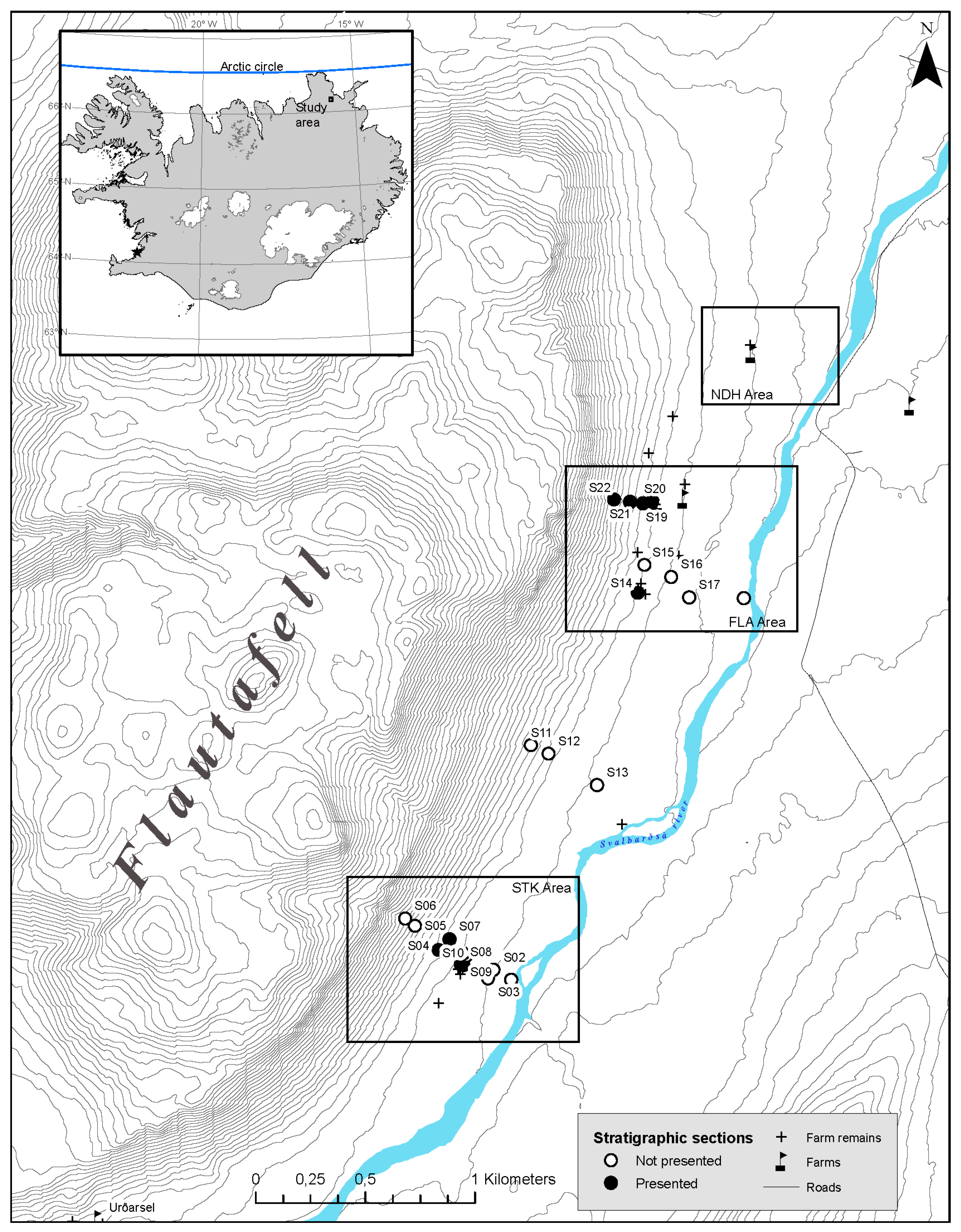
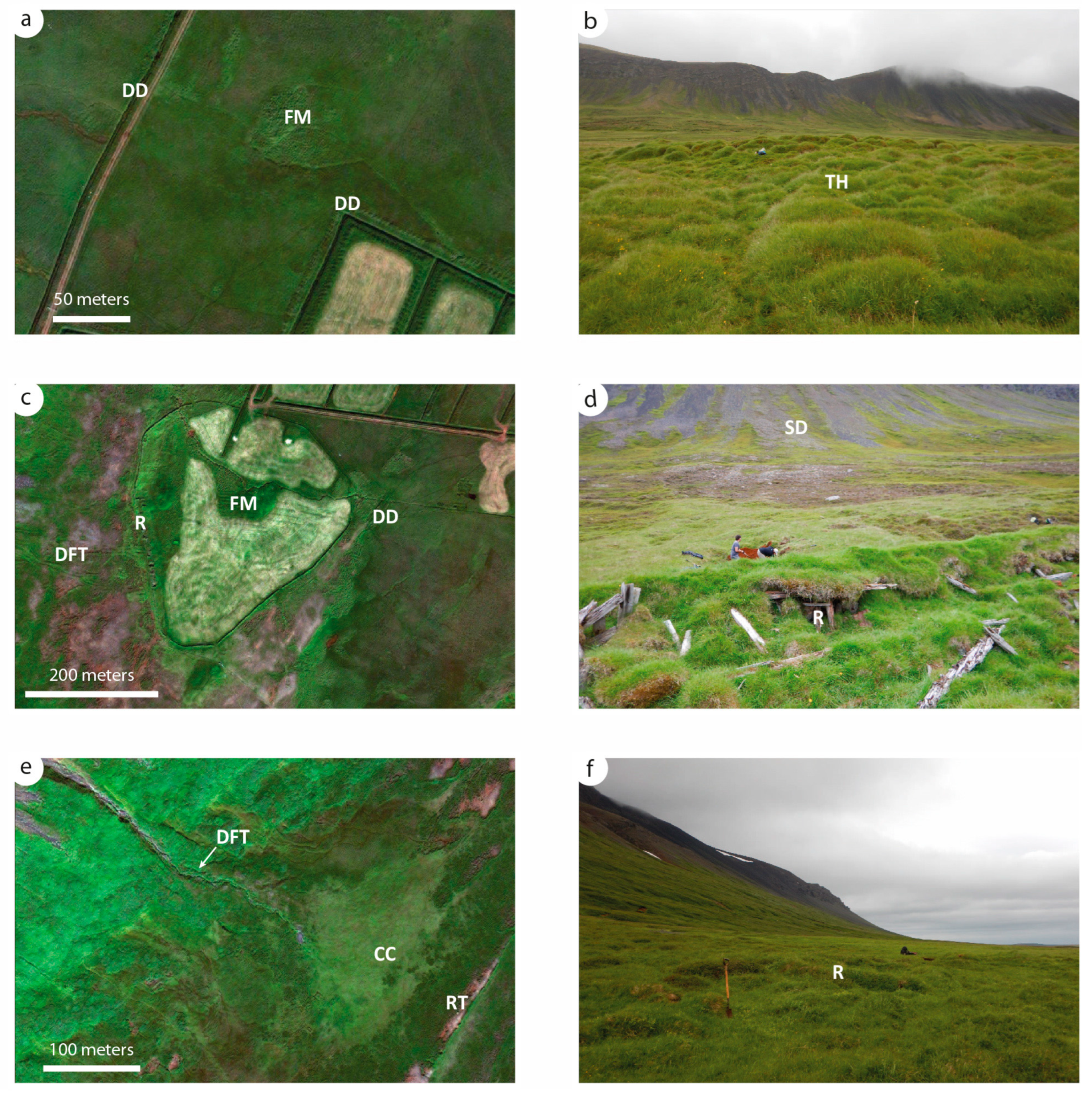
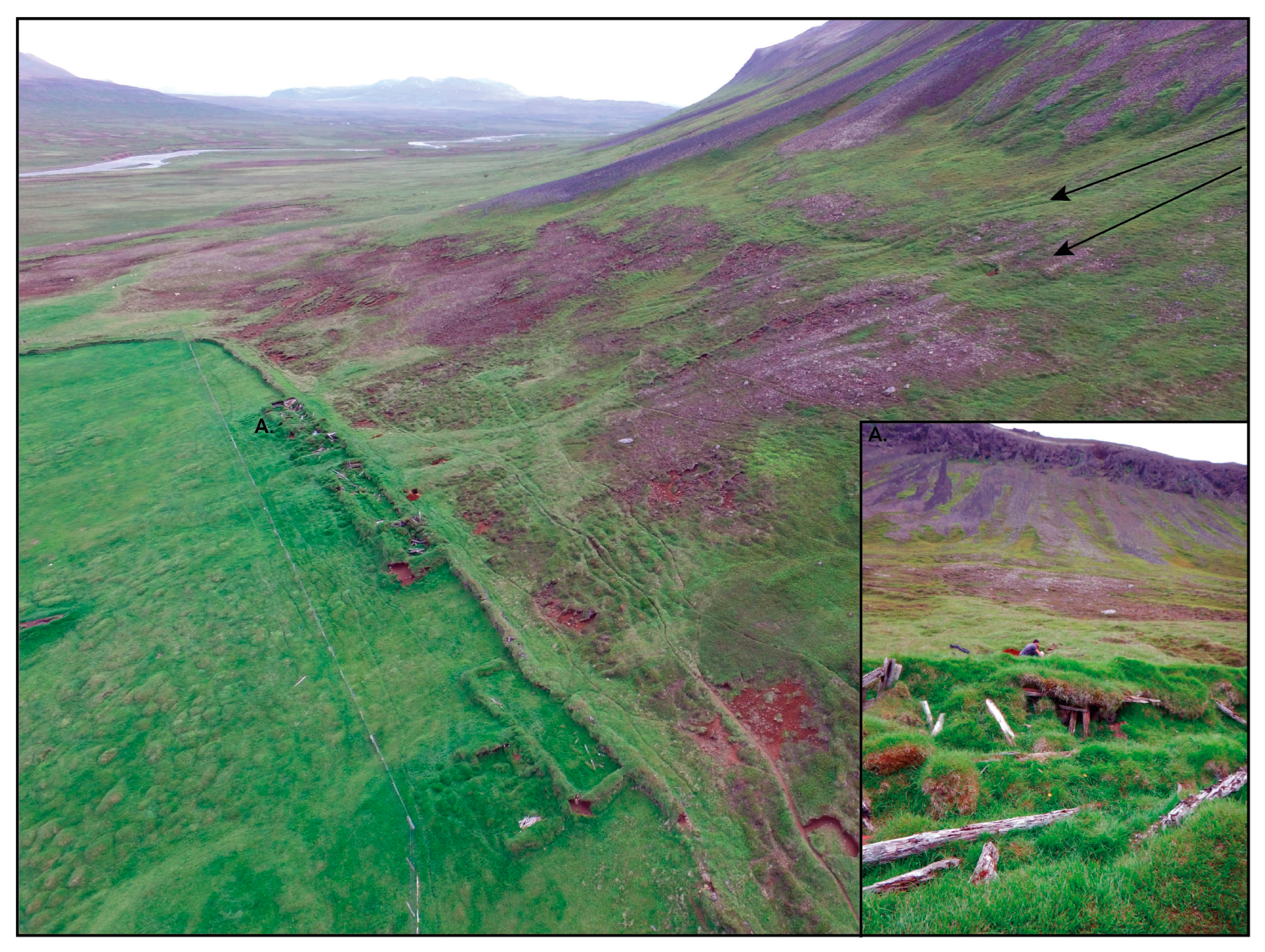
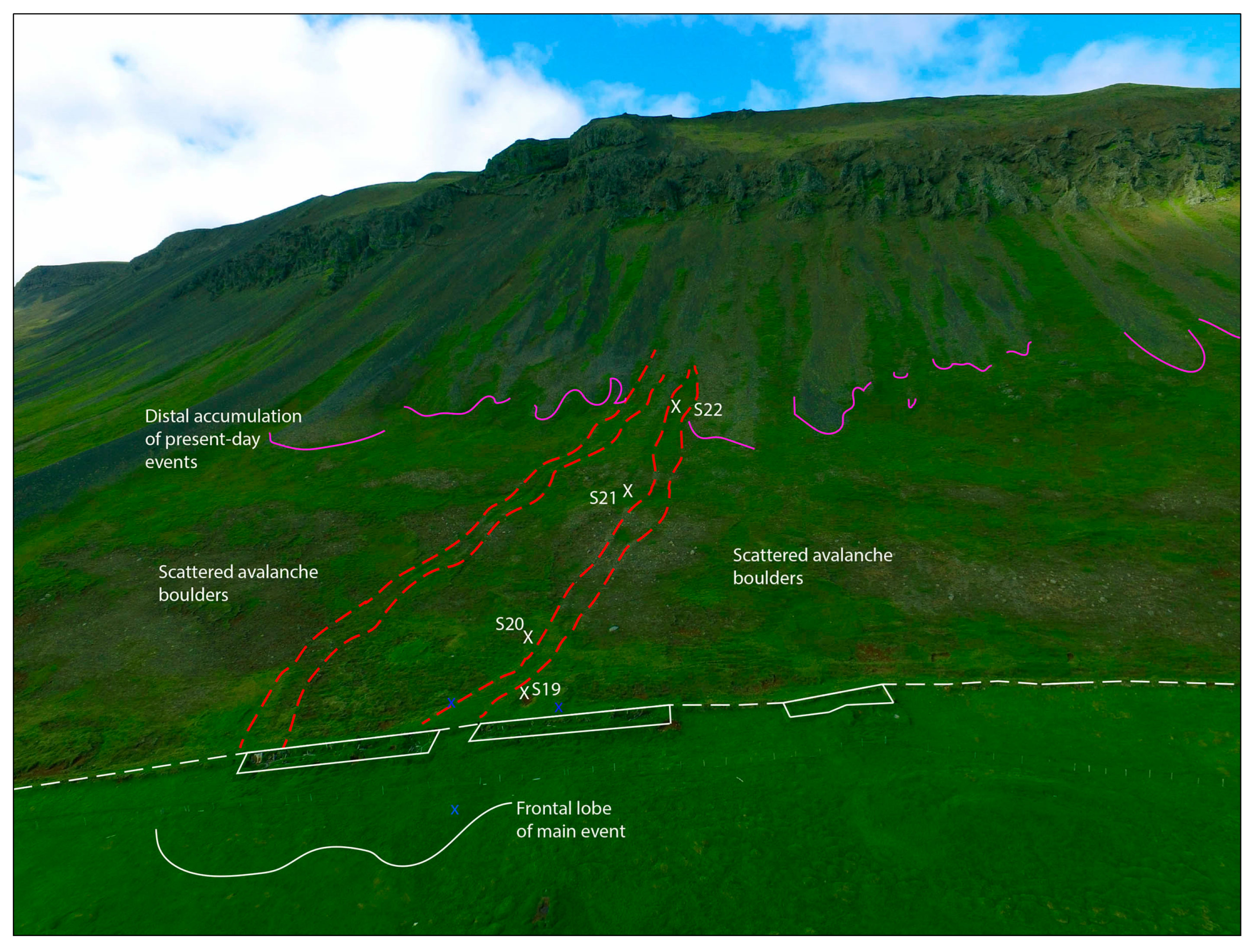
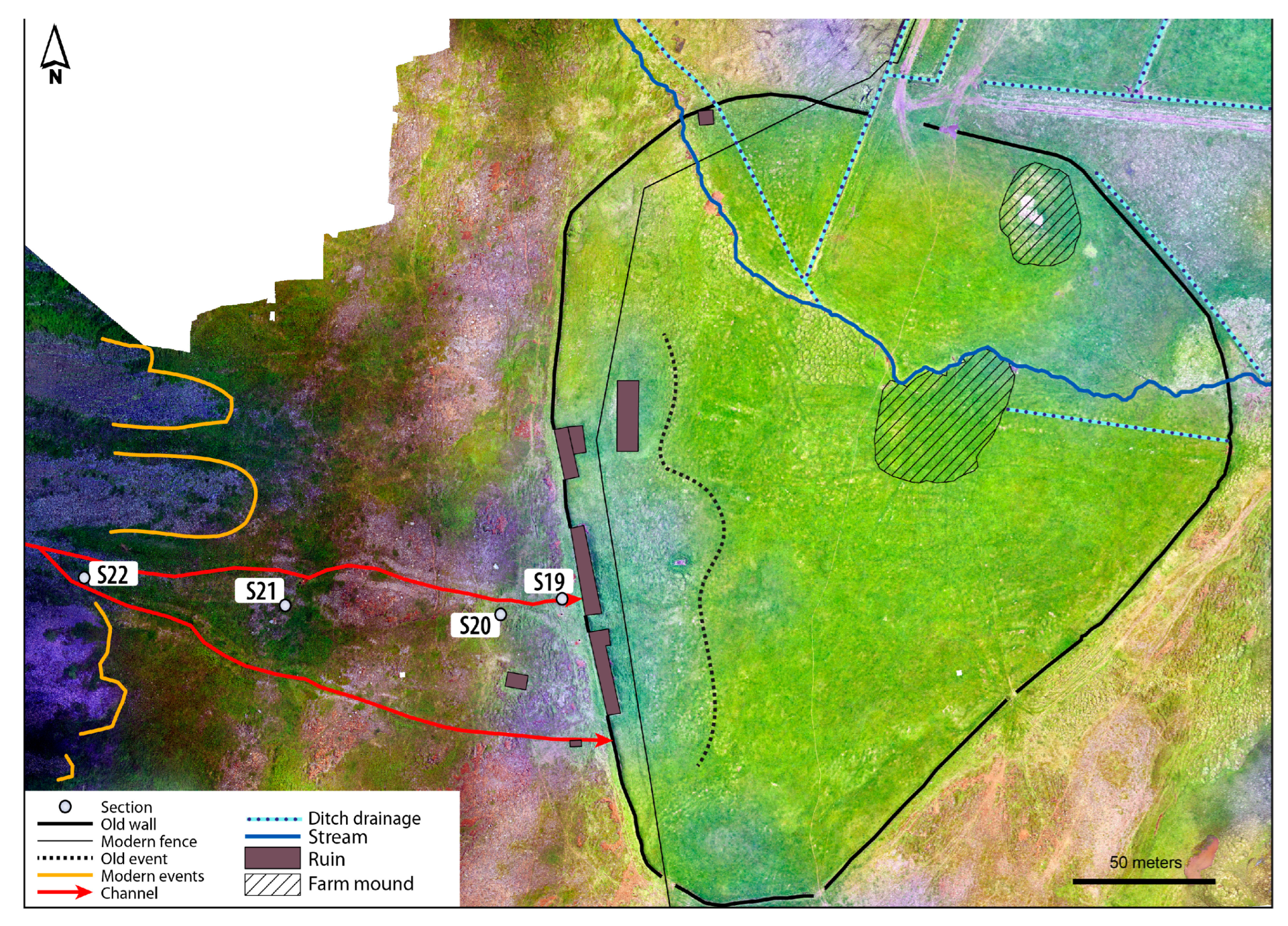
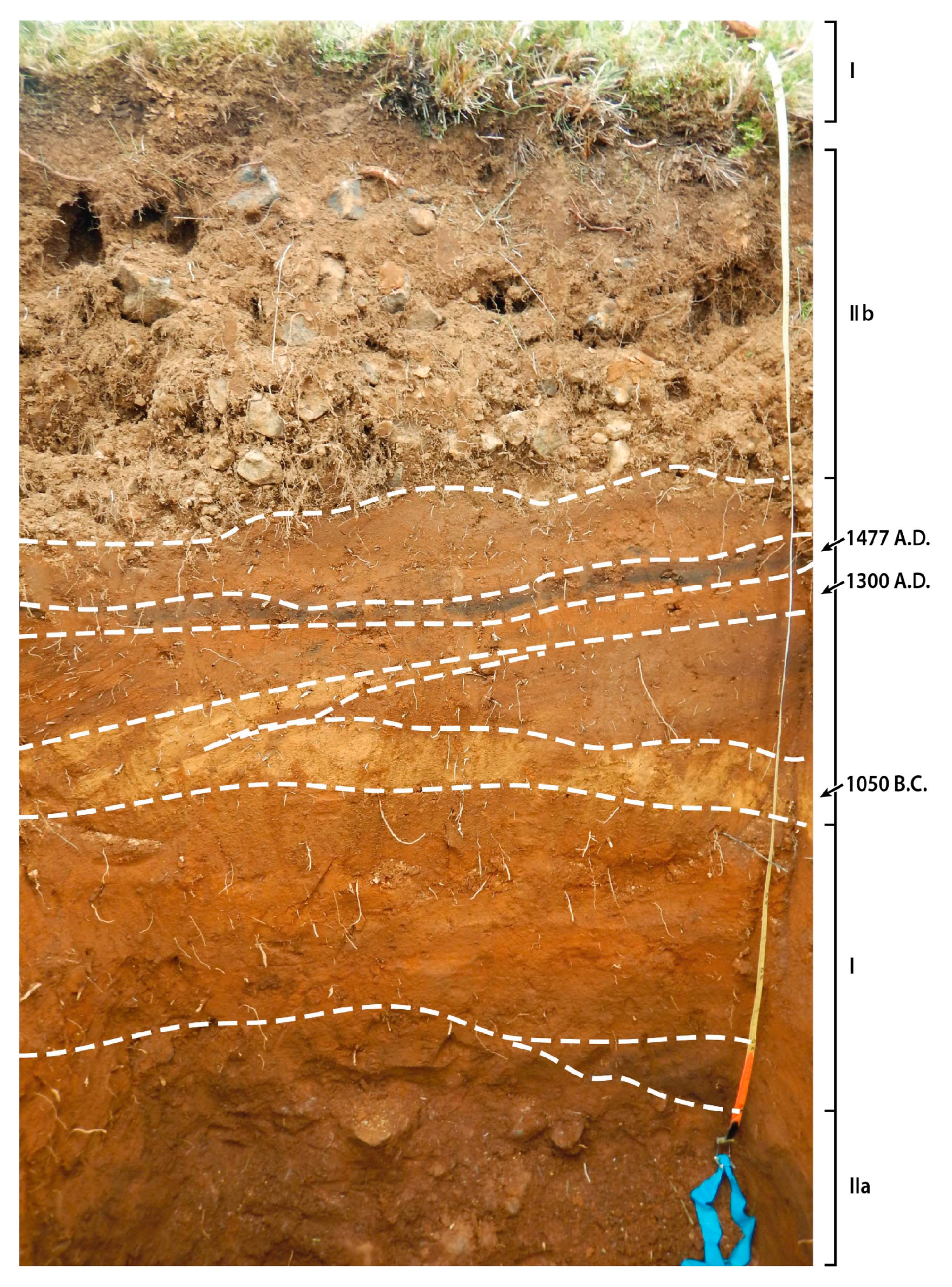
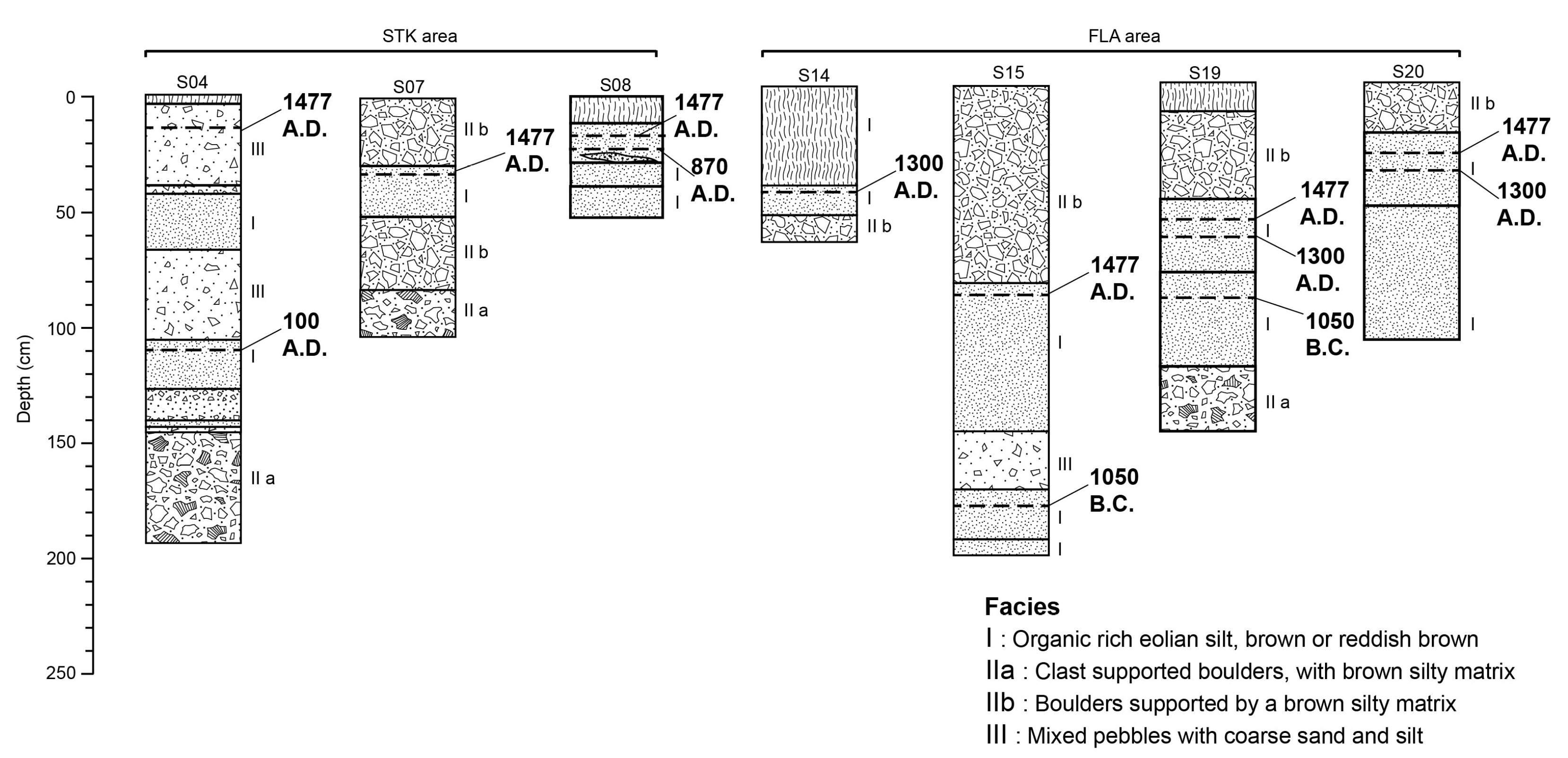
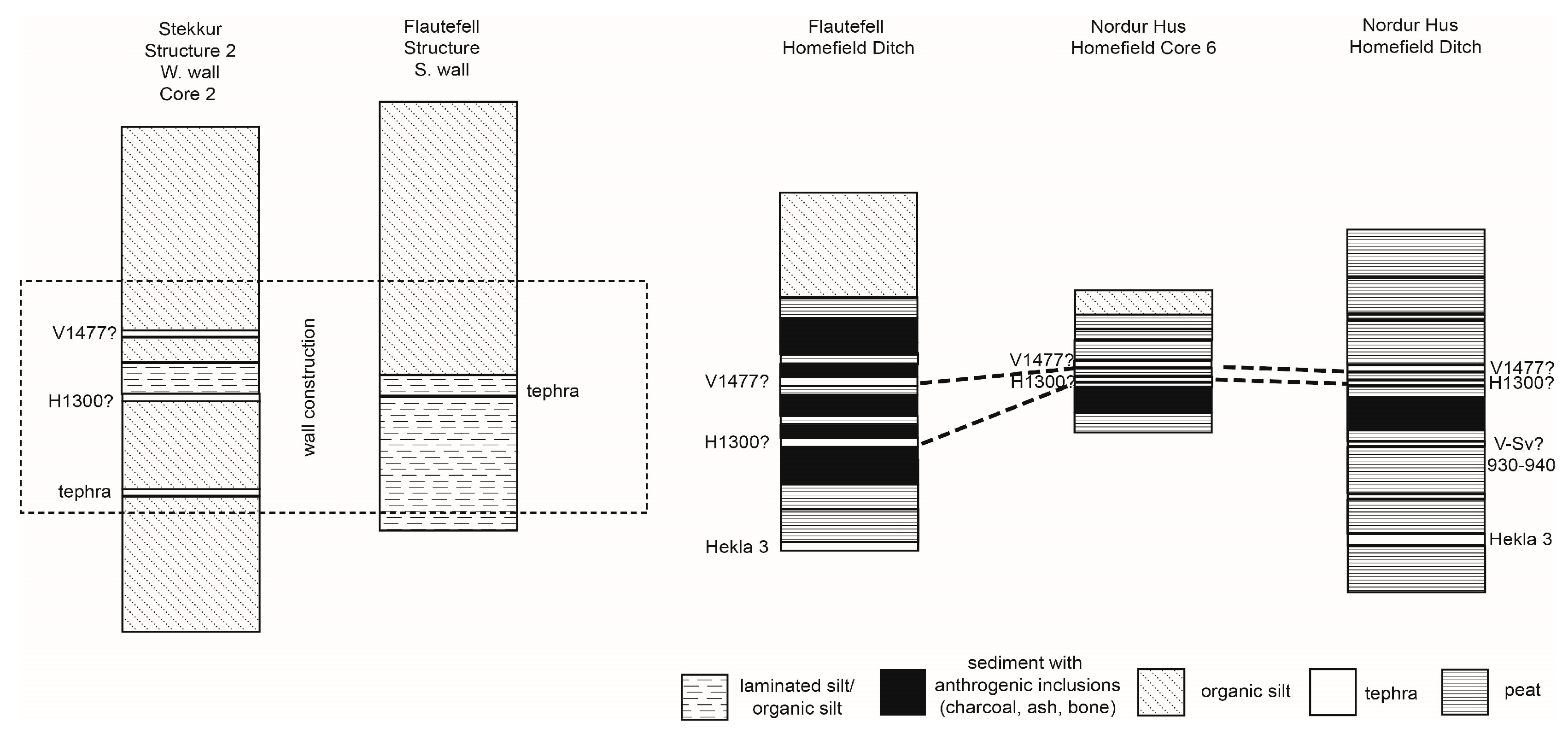
Disclaimer/Publisher’s Note: The statements, opinions and data contained in all publications are solely those of the individual author(s) and contributor(s) and not of MDPI and/or the editor(s). MDPI and/or the editor(s) disclaim responsibility for any injury to people or property resulting from any ideas, methods, instructions or products referred to in the content. |
© 2023 by the authors. Licensee MDPI, Basel, Switzerland. This article is an open access article distributed under the terms and conditions of the Creative Commons Attribution (CC BY) license (https://creativecommons.org/licenses/by/4.0/).
Share and Cite
Lebrun, J.; Bhiry, N.; Woollett, J.; Sæmundsson, Þ. Slope Dynamics in Relation to the Occupation and Abandonment of a Mountain Farm in Þistilfjörður, Northeast Iceland. Geosciences 2023, 13, 30. https://doi.org/10.3390/geosciences13020030
Lebrun J, Bhiry N, Woollett J, Sæmundsson Þ. Slope Dynamics in Relation to the Occupation and Abandonment of a Mountain Farm in Þistilfjörður, Northeast Iceland. Geosciences. 2023; 13(2):30. https://doi.org/10.3390/geosciences13020030
Chicago/Turabian StyleLebrun, Julien, Najat Bhiry, James Woollett, and Þorsteinn Sæmundsson. 2023. "Slope Dynamics in Relation to the Occupation and Abandonment of a Mountain Farm in Þistilfjörður, Northeast Iceland" Geosciences 13, no. 2: 30. https://doi.org/10.3390/geosciences13020030
APA StyleLebrun, J., Bhiry, N., Woollett, J., & Sæmundsson, Þ. (2023). Slope Dynamics in Relation to the Occupation and Abandonment of a Mountain Farm in Þistilfjörður, Northeast Iceland. Geosciences, 13(2), 30. https://doi.org/10.3390/geosciences13020030






